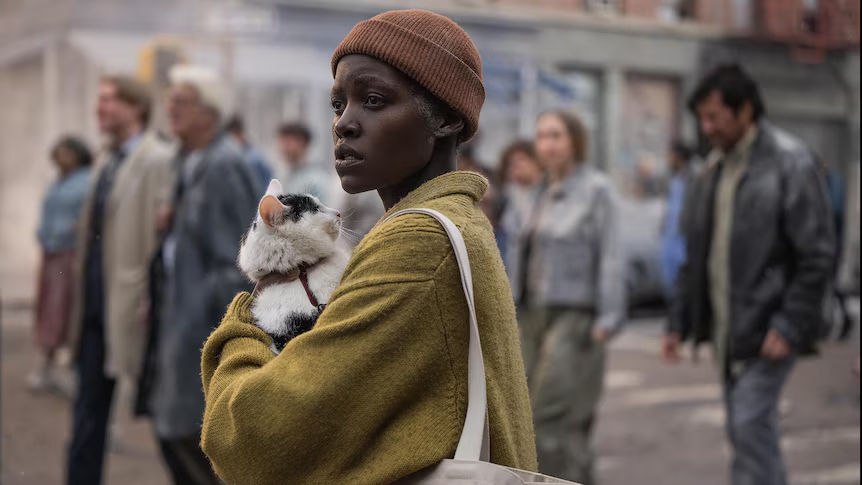Part of the allure of the disaster movie genre is allowing viewers to impart themselves within the chaos and anarchy of overwhelming events ranging from out-of-control weather to invasive alien forces. It’s one of my favorite genres, full of exemplary filmmakers who have strived to envision what the end of the world means to them. The Quiet Place films have carved out their own unique cultural space; they’re high-concept films that rely on both the characters and audience members remaining silent, which feeds into the intensity of alien creatures that hunt by sound. It’s a neat idea that has easily lent itself to two highly successful films that have catapulted John Krasinski and Emily Blunt to the higher echelons of Hollywood. One has to ask: how does the third prequel (this latest takes place on day one of the alien invasion) match the qualities of the previous films without the same characters or creative forces at the helm?
Coming off an exciting directorial debut with Pig (2021), Michael Sarnoski infuses A Quiet Place: Day One (2024) with a level of emotional intelligence that feels absent in most thrilling blockbusters. There’s a version of this film that would delve into the militaristic machinations of battle sequences and military leaders dealing with the chaos, yet that’s not why these films work. They’re films that pit characters united by their tethered connections through family and community, and the same applies to Day One. While Blunt and her family don’t appear (as their day one is showcased in Part II), Lupita Nyong’o plays one of her most compelling characters to date.
Day One is perhaps the franchise’s most daring entry because it often focuses on intimate character study rather than explosive spectacle. Sarnoski crafts an emotionally charged blockbuster that dazzles the screen and the mind. While explosions and monster mayhem are present, they merely function as background noise to a narrative that asks: “What are the things most precious to us when facing impending doom?”
Samira (Nyong’o) — referred to as Sam —currently spends the remainder of her days in hospice care. Already this is a drastic change in expectation, as Sarnoski (who handles both writing and directing duties) communicates our lead character is on borrowed time. As such, Sam lives without much to look forward to other than tending to her therapy cat, Frodo. Sam joins a trip organized by her nurse, Eric (Alex Wolff), alongside other hospice patients into Manhattan. Naturally, this happens to be the same day that alien creatures crash land on Earth.
As the creatures kill and destroy the city, Sam focuses on survival, learning the rules of remaining quiet. In this chaos, Samira meets Henri (Djmoun Hounsou, reprising his role from Part II. Henri’s appearance feels like an ill-executed piece of studio-mandated connective tissue, but, thankfully, the film doesn’t forget that Sam is the star.). Her mission and guiding light in the chaos is to reach Harlem to eat what could be her last slice of pizza from her favorite place. This solo journey propels her into an unlikely companionship with a stranger, Eric (Joseph Quinn), an English law student, whose own anxiety and fears of the unknowable compel him to stick alongside Sam and Frodo.
The duo’s strange, grounded relationship separates Day One from other summer films that would cheaply find a way to force Nyong’o into an action heroine role and somehow find a cure for her cancer. Sarnoski isn’t interested in appeasing an audience seeking a quick reprieve from reality. Rather, he emphasizes some of the most understated beauties in our world, like eating pizza or becoming friends with a stranger.
The previous Quiet Place films focused on the core strength of a nuclear family strengthened by love and commitment to preservation. Sarnoski knows Day One offers no hope for Sam or Eric, as it roots us in the thrilling survivalist element of characters learning and circumventing obstacles to survive. The narrative is straightforward, not broadening its scope beyond the eyesight of Sam and Eric. It’s a unique perspective specific to the prequel.

Nyong’o imbues Sam with a tangible beauty and depth that rivals Krasinski and Blunt’s characters. She delivers a phenomenal performance that gravitates between the cynicism of being dealt a death card and the instinctual human desire to survive. It may be arbitrary for them to seek pizza, yet that desire is what makes her journey both relatable and resonant. Nyong’o grounds the film on an emotional catharsis that feels so rare for a project of this type. Only a performer like her can create a character so deftly layered and beautiful that it emphasizes her co-star in Quinn. It’s saddening how few projects she gets to lead, but seeing her present in nearly every frame of this film is a welcome change of pace for Hollywood.
Joseph Quinn, whose character is introduced halfway into the movie, has the most difficult challenge in capturing the audience’s attention with little screen time. We don’t know why he begins to follow Sam, yet their friendship develops into a meaningful ode to retaining one’s humanity amid disaster. Eric is scared, with a family across an ocean that displaces him. His quiet vulnerability helps break down the callous shield Sam has put around her cancer diagnosis; their relationship thus becomes a focal point of the film. Quinn gives a lovely performance that compliments Nyong’o’s strong-willed nature.
Sound design and mixing are top-notch. The previous films showcased the creatures wreaking havoc in the isolated forest, but the series now finds itself in a city that quite literally functions through noise. The film elevates a different type of suspense to a town in ruins and people unfamiliar with the rules.
The stark images showcased by cinematographer Pat Scola add a different level of horror and fear. Scenes of people covered in ash and walking away from street-filled debris beckon images of a post-9/11 scale of destroyed cityscapes and a traumatized New York. It’s a startling work that calls back to Spielberg’s War of the Worlds (2005); in a similar vein, both blockbusters focused solely on the human drama of surviving a full-scale alien invasion.
Sarnoski keeps his camera focused on the perspective of Sam and the people around her. In one incredible scene, she and Eric run through a glass-encased lobby of a building while the camera pans upwards, showing creatures hurtling downward from skyscrapers. Gregory Plotkin and Andrew Mondsheinam’s editing plays a crucial role in a sequence where Sam encounters citizens casually walking to evacuation boats. We witness the subtle noises from closeup edits of shuffling feet and loud roller bags that emphasize people not considering how loud they can be in such an environment.
Day One may not feel like a traditional prequel in providing the viewer answers as to where or why the alien creatures came to Earth. Rather, the film asks the audience to consider our last day on Earth, and how we would spend it. What would we want to eat? Sarnoski crafts not only one of the best prequels of the year but also a big-budget film that carves out a special space for a little glimmer of humanity that sets the seeds of why the Quiet Place films work so well: it’s maintaining and remembering what makes us human and why we revere being human.
Review Courtesy of Amritpal Rai
Feature Image Credit to Paramount Pictures via Filmiloc

Recent Comments